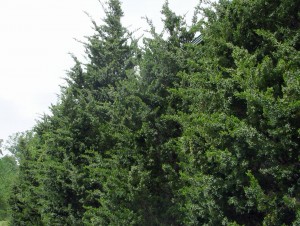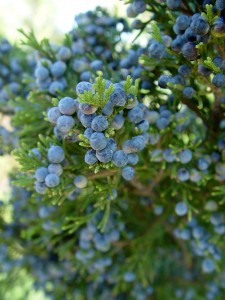Eastern red cedar
* Common name: Eastern red cedar

Eastern red cedars used as a screen planting.
* Botanical name: Juniperus virginiana
* What it is: A drought-tolerant, native, upright, pyramidal evergreen with stiff green to bluish-green needles. Females get attractive pea-sized fruits that mature to a waxy blue-gray in late summer and make good winter food for birds.
* Size: The species grows 8 to 10 feet wide and 30 to 40 feet tall. Shorter and narrow varieties are available, including some with golden needles.
* Where to use: Eastern red cedar does best in hot, sunny spots and tolerates fairly poor soil. They’re attractive enough – especially in fall – to make front-yard or house-corner specimens, but they’re also useful for screening purposes when planted in a line along a sunny border. Dwarf types can be used for flanking doorways or arbors.

Fruits of eastern red cedar.
* Care: Keep damp the first 2 seasons to establish the roots, then eastern red cedars can usually go without water except in the worst droughts. These are heat-tolerant, too. Optional: fertilize with an annual spring scattering of acidifying, organic, granular fertilizer. Pruning not needed unless plants grow beyond allotted space, in which case they can be pruned or sheared lightly at the end of winter. Never cut back into bare wood.
* Great partner: Shrub roses or spirea make good shrub partners. Liatris, tall garden phlox and coneflowers are good native-perennial partners. Creeping sedum ‘John Creech’ is a good groundcover for planting under and around red cedars.







